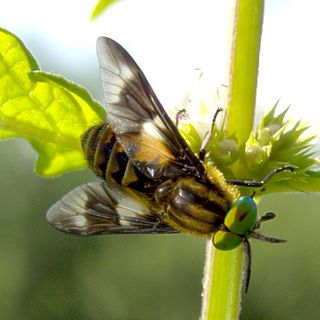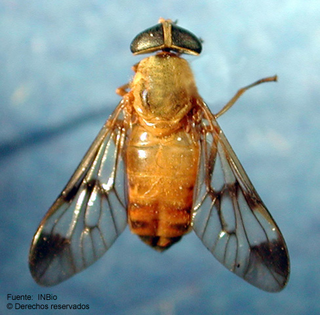
Stonemyia is a genus of flies in the family Tabanidae.

Tabanus nigrovittatus, also known as the greenhead horse fly, salt marsh greenhead, or simply the greenhead fly, greenhead or greenfly, is a species of horse-fly commonly found around the coastal marshes and wetlands of the Eastern United States. They are smaller than most horsefly species, instead being close in size to a common housefly. The biting females are a considerable pest to both humans and animals while they seek a source of blood protein to produce additional eggs: greenhead larvae develop in the mud of salt marshes, and adult flies mate and lay their first group of eggs in the marsh, but to lay more eggs a female fly needs to drink an animal's blood, and so female greenheads which have laid eggs fly inland to look for prey in the area bordering the marsh; they can stay on land looking for animals to bite for up to four weeks. Their bites itch, like those of mosquitoes, but are more painful, since greenheads feed by cutting a wound in the skin with scissor-like mouth parts and sucking the blood released through it. Females live for three to four weeks and may lay about 100 to 200 eggs per blood meal. The eggs are laid on the grass in a salt marsh; the larvae live in the intertidal mud of the salt marsh for one or two years, preying on other invertebrates, before pupating in early spring. The adult flies emerge in late spring and are most common from late June to August.

Superfamily Tabanoidea are insects in the order Diptera.

Osca lata, the coliguacho or black horse fly, is a large horse fly whose range includes southern Chile and southern Argentina. The fly has a striking reddish-orange coloration on the side of its thorax and abdomen. It is generally around 2 cm. in adult size.

Diachlorus ferrugatus, commonly known as the yellow fly in the United States or doctor fly in Belize, is a species of highly aggressive biting horse-fly of the family Tabanidae native to North and Central America to Costa Rica.

Diachlorini is a tribe of horse flies in the family Tabanidae.

Chrysops callidus is a species of deer fly in the family Tabanidae.
Stonemyia rasa is a species of fly in the family Tabanidae.

Chrysopsinae is an insect subfamily in the family Tabanidae commonly known as deer flies or sheep flies and are bloodsucking insects considered pests to humans and cattle. They are large flies with large brightly-coloured compound eyes, and large clear wings with dark bands. They are larger than the common housefly and smaller than the horse-fly.

Tabanus americanus, the American horse fly, is a species of horse-fly in the family Tabanidae.

Silvius gigantulus is a species of horse fly in the family Tabanidae.
Stonemyia californica is a species of fly in the family Tabanidae.
Chrysops montanus is a species of deer fly in the family Tabanidae.
Tabanus dorsifer is a species of horse fly in the family Tabanidae.
Chrysops frigidus is a species of deer fly in the family Tabanidae.
Goniops chrysocoma is a species of fly found in North America. It is the only species in the genus Goniops, which is in the horse and deer flies family Tabanidae.
Chrysops ater is a species of deer fly in the family Tabanidae.
Stonemyia isabellina, is a species of fly in the family Tabanidae.
Stonemyia tigris is a species of fly in the family Tabanidae.
Pegasomyia is a genus of flies in the family Tabanidae.











